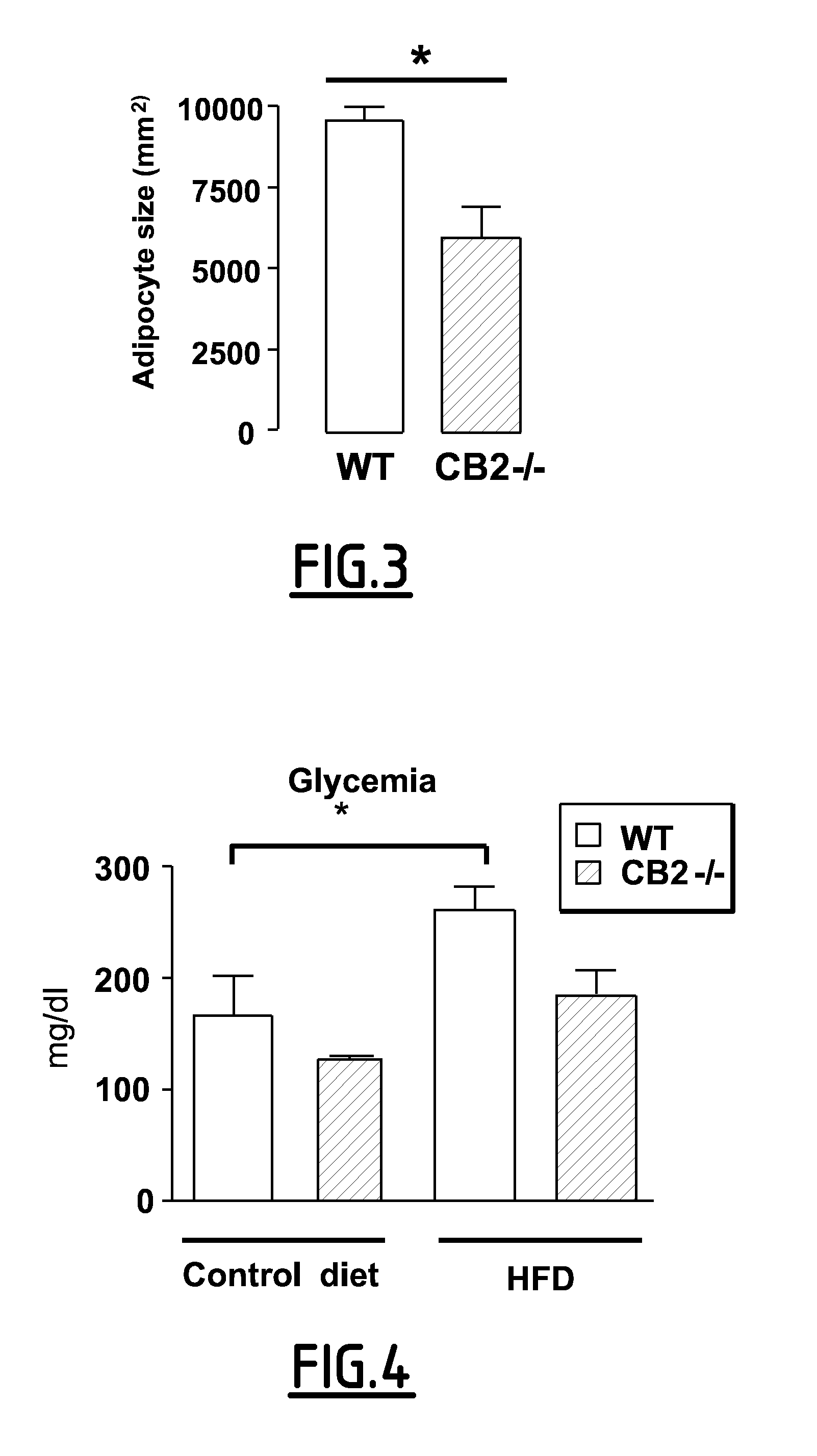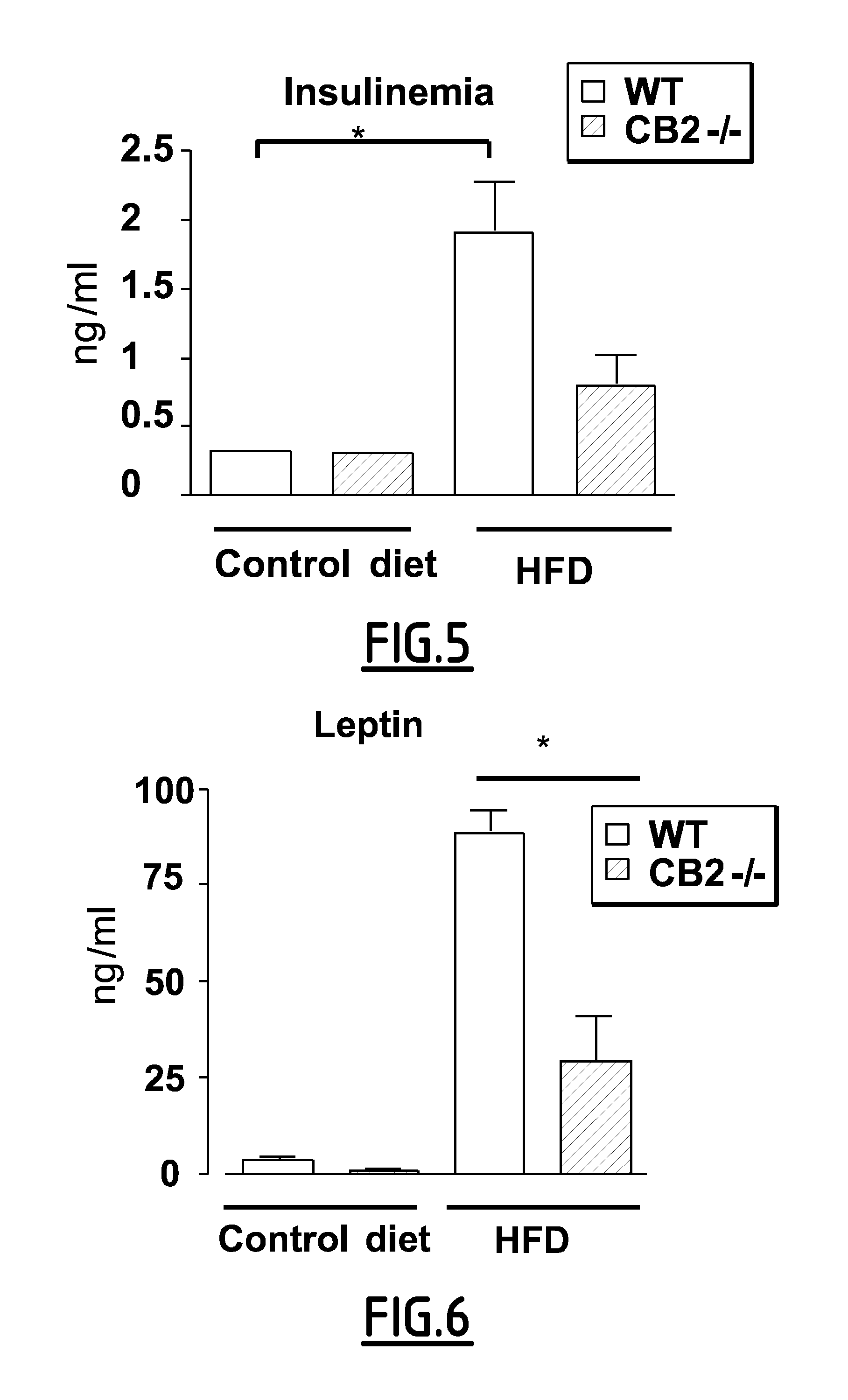Method of treating insulin resistance with a selective inhibitor of CB2 receptor activity
a cb2 receptor and activity technology, applied in the direction of drug composition, metabolic disorder, cardiovascular disorder, etc., can solve the problems of limited efficacy and significant side effects of weight loss drugs currently used for the treatment of obesity, increased risk of cardiovascular complications, and increased risk of cirrhosis
- Summary
- Abstract
- Description
- Claims
- Application Information
AI Technical Summary
Benefits of technology
Problems solved by technology
Method used
Image
Examples
example 1
Methods
[0157]Animals and Experimental Design: The generation of mice with a targeted mutation of the CB2 gene on a mixed genetic background has been described previously (Buckley, N. E et al. 2000). Wild type C57BL / 6, ob / ob and ob / ob+mice were obtained from Janvier (France).
[0158]Adult male mice (7-10 week-old) were housed under 12 hours of light / 12 hours of dark cycle, in a temperature-controlled environment. Wild type mice (WT) and CB2− / − mice were fed either standard chow (TD 2016, Harlan) or high fat diet (36% fat, TD 99249, Harlan) for 15 weeks. Body weight and food intake were measured weekly. Mice were sacrified after overnight fasting. All experimental protocols were conducted in accordance with French government policies (Services vétérinaires de la Santé et de la production animale, Ministère français de I'Agriculture).
[0159]At the time of sacrifice, brown and white (subcutaneaous inguinal (SAT) and epididymal (EAT)) adipose tissues were removed, weighed and snap frozen in...
example 2
Methods
[0180]Animals and Experimental Design: Experimental protocols were conducted in accordance with French government policies (Services véterinaires de la Santé et de la production animale, Ministère français de ('Agriculture). Animals were housed under 12 hours of light / 12 hours of dark cycle, in a temperature-controlled environment. The impact of the CB2 antagonist AM630 was evaluated in 6 week-old male obese LepOb / LepOb male mice (ob / ob) and lean LepOb+ / LepOb counterparts (ob+ / ob). Mice received an 17 day-course of daily intraperitoneal injection of 1 mg / kg AM630 (n=10 ob / ob and n=5 ob+ / ob) or vehicle (n=8 ob / ob and n=5 ob+ / ob). AM630 (Tocris) was freshly dissolved in a vehicle solution containing 1 drop of Tween 80 in 0.1 ml dimethylsulfoxide (DMSO), sonicated, and further diluted 50 times in NaCl 9%. Body weight and food intake were measured daily. Mice were sacrificed after overnight fasting. White epididymal adipose tissue was removed, weighed and either fixed in buffered...
PUM
| Property | Measurement | Unit |
|---|---|---|
| pH | aaaaa | aaaaa |
| resistance | aaaaa | aaaaa |
| insulin resistance | aaaaa | aaaaa |
Abstract
Description
Claims
Application Information
 Login to View More
Login to View More - R&D
- Intellectual Property
- Life Sciences
- Materials
- Tech Scout
- Unparalleled Data Quality
- Higher Quality Content
- 60% Fewer Hallucinations
Browse by: Latest US Patents, China's latest patents, Technical Efficacy Thesaurus, Application Domain, Technology Topic, Popular Technical Reports.
© 2025 PatSnap. All rights reserved.Legal|Privacy policy|Modern Slavery Act Transparency Statement|Sitemap|About US| Contact US: help@patsnap.com



